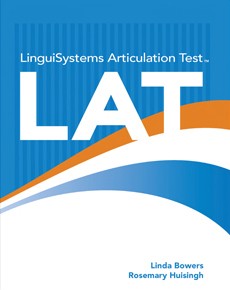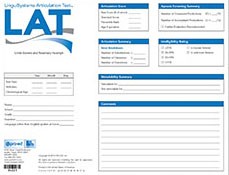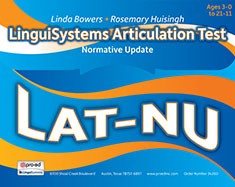*DISCONTINUED (*NEW EDITION in Alternatives below)
The LAT was designed to identify children and young adults with abnormal articulation patterns. It ensures a thorough examination of all sounds and blends by presenting several sounds more than one time in the same position. All positions at the word level are tested.
Test results, in combination with the stimulability and intelligibility ratings and a Childhood Apraxia of Speech Screening included with the LAT, allow the SLP to make appropriate recommendations regarding the type and length of service. An accurate diagnosis leads to best practice therapy.
The LAT can also be used to measure progress in therapy.
Test Description
The LinguiSystems Articulation Test consists of five picture plates that assess all the consonant sounds in words, including initial blends. The vocalic /r/ is tested in multiple contexts.
The Stimulability Assessment, administered immediately after an incorrect production is made, determines if the student is able to imitate a correct production.
The Intelligibility Rating Scale is based on the student's type and frequency of errors in a picture description task and helps you determine the type and severity of the speech-sound disorder.
The Articulation Summary is based on the student's type of speech-sound erors at the single-word level. This allows you to break down the speech-sound errors by substitution, omission, or distortion.
The Apraxia Screening Summary is based on the student's sequential productions of twelve multisyllabic words. Inconsistent repetition of a multisyllabic word may lead to follow-up tests regarding Childhood Apraxia of Speech (CAS).
The Speech Sound Error Analysis is a two-page summary in the test form that allows you to visually analyze the student's speech errors by word location, type, and stimulability. All phonemes tested in the LAT are included in the Speech Sound Error Analysis.
The LAT is easy to administer, score, and interpret.
Test Procedures
- Begin with Plate I, Item 1 regardless of the student's age. Present each item verbally and administer every item. Basals and ceilings are not used. Write the student's response verbatim on the test form. Allowable prompts are provided for each item.
- For Stimulability items, test only the sounds in which an error occurred.
- For Apraxia Screening items, point to each picture and ask the student to say each word three times.
Scoring/Types of Scores
A score of 1 or 0 is assigned to each target sound in the stimulus word. A score of + or - is assigned to sound productions in the stimulability testing.
Total Number of Errors can be converted to:
- Age Equivalents
- Percentile Ranks
- Standard Scores
Discussion of Performance
The Discussion of Performance section found in the Examiner's Manual helps you bridge from assessment to treatment.
Once you've identified the type and severity of your student's disorder, review this section to determine the therapy approach most appropriate for your student. The Phonological Processing Approaches, Phonological Contrasts Approaches, and Core Vocabulary approach are described in sufficient detail to help you make the determination.
The special populations of Childhood Apraxia of Speech (CAS) and Dysarthria are also addressed in this section.
Standardization and Statistics
The LAT was standardized on 3,030 subjects and an additional 700+ subjects were included in the LAT/GFTA-2 Comparison Study. These subjects represented the latest National Census for race, gender, age, and educational placement.
- Reliability—established by the use of test-retest and internal consistency methods for the total test at all age levels. The median reliability coefficient is .90 and the SEM is 3.39. The median item homogeneity coefficient is .91. Reliability tests include:
- Test-Retest
- SEM
- Item Homogeneity (KR20)
- Validity—established by the use of content validity which indicated the speech sounds selected were those reflective of phoneme development in children. Contrasted groups and concurrent validity revealed that the test significantly discriminates between typically-developing subjects and subjects with speech-sound disorders. All of the correlations are significant at the .01 level. Validity tests include:
- Contrast Groups (t-values)
- Analysis of Variance (ANOVA)
- Race/Socioeconomic Group Difference Analysis—conducted at the item and subtest levels. Tests included Analysis of Variance (ANOVA), Z tests and Chi Square analysis at the subtest level. Race/socioeconomic level were not found to be strong factors.
- Copyright 2010, 2011

 Proud to be Canadian
Proud to be Canadian


